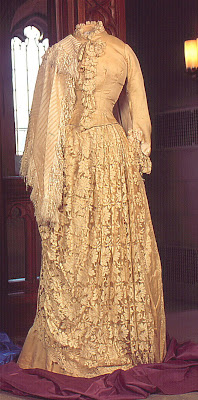Last Friday was the first meeting of all the participants of the Historic Costume Preservation Workshop (HCPW) at Vassar. It was a wonderful opportunity for all of us to meet each other . . . and to jump right in! First I gave a brief introduction to the project, and some principles of handling the objects. Then I gave a brief tour of the space, for those who are new to it.

Then everyone broke into groups to examine and discuss some objects from the collection. The group assigned to discuss the 1830’s-1860’s had a teal ruffled crinoline dress as their focus point. The 1870’s-1900’s group examined a brown bustle ensemble. There was also a 1910’s-1930’s group, looking at a 1910’s gown, and a 1940’s-1970’s group, who examined two women’s suits and a cocktail dress. Each group was given a short packet of reading about their assigned period, and a stack of books and image folders to flip through for visual references for the period in question.
Since many of the participants are coming to this project with no background in costume history, some felt challenged to adequately describe what they were seeing without the right vocabulary or technical knowledge to back it up. For example, some tried to determine the fiber or weave of the fabric or use patternmaking terms to describe the cut of a sleeve. I encouraged them that we would address those issues over the course of the semester, but that this exercise was about observation, and that they should stick to what they could observe with their senses, rather than any previous technical knowledge. Rather than deciding if a fabric is silk, they were prompted to describe its qualities: soft or stiff? opaque or transparent?
Already the group is paying great attention to detail, and asking the right kinds of questions about the objects – questions we hope to answer over the course of the project, even if we couldn’t do so on the spot yesterday.
Once they had closely examined their object, each group moved into their reference materials (reading and images) to discuss common features of the period in question and how their object fit into the styles of the times. At this point they were about fifteen minutes into the activity. I went around and assigned each person in each group a specific focus: either silhouette, fabrics, trims and notions, or technique.
After another fifteen minutes, everyone re-grouped into these feature groups. The technique group was stationed at the teal crinoline dress, and the person who had already worked with that dress presented it to the rest of her group, discussing aspects of technique. The other groups were similarly stationed with other objects. After five minutes, each group rotated to a new object. That way everyone was able to see every object, and to get a sense of the features of each period.
As we begin our survey of the collection this week, they’ll be regrouped again for their lab groups, so that each group will have an “expert” from each of the four time periods, and each person is also an “expert” in a particular physical feature of costume history. Over the course of the semester, we’ll all be adding to our expertise, by learning from the professional consultants who are coming in to teach us, from appropriate reference materials, and most importantly, from the objects themselves.

